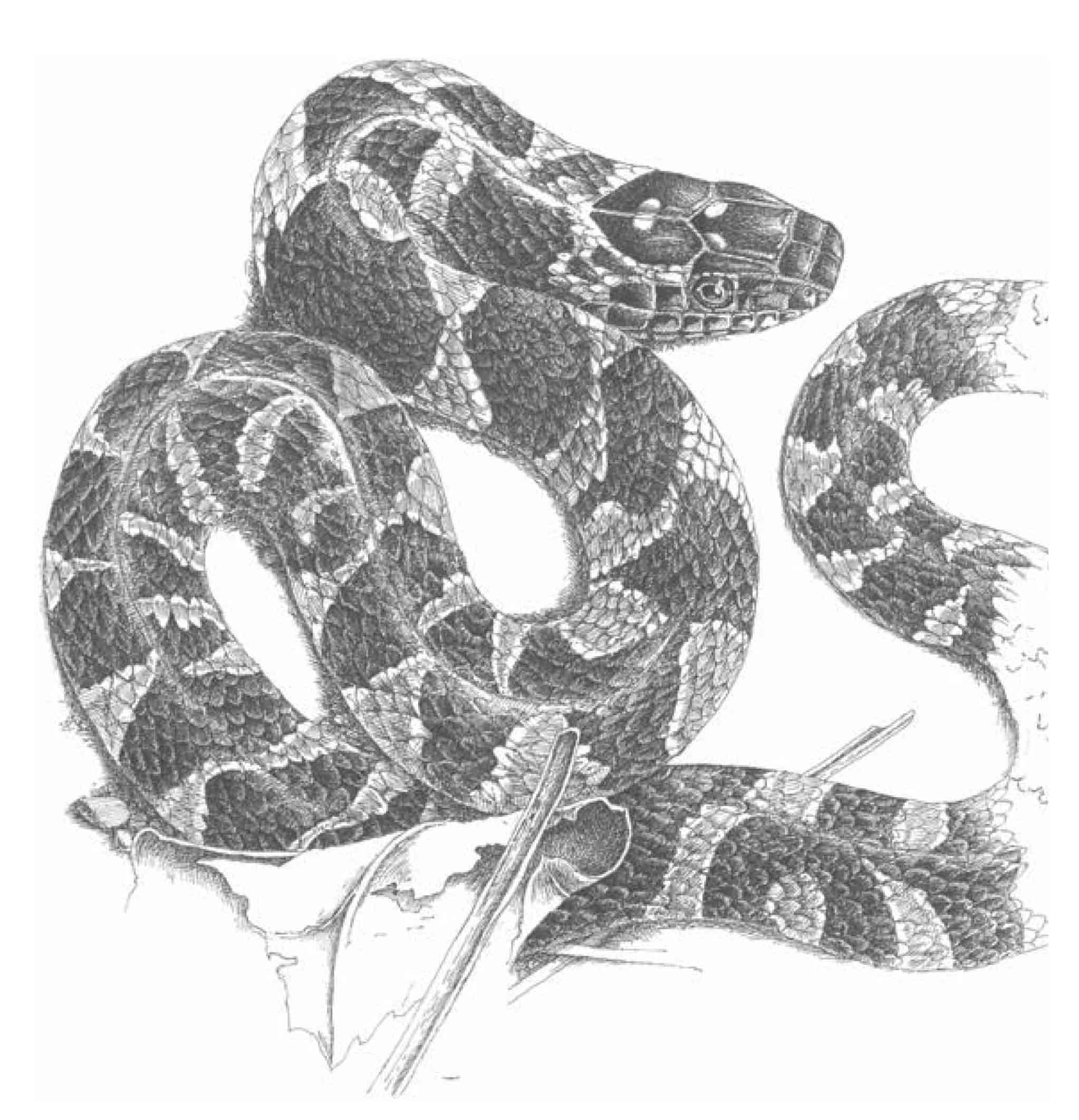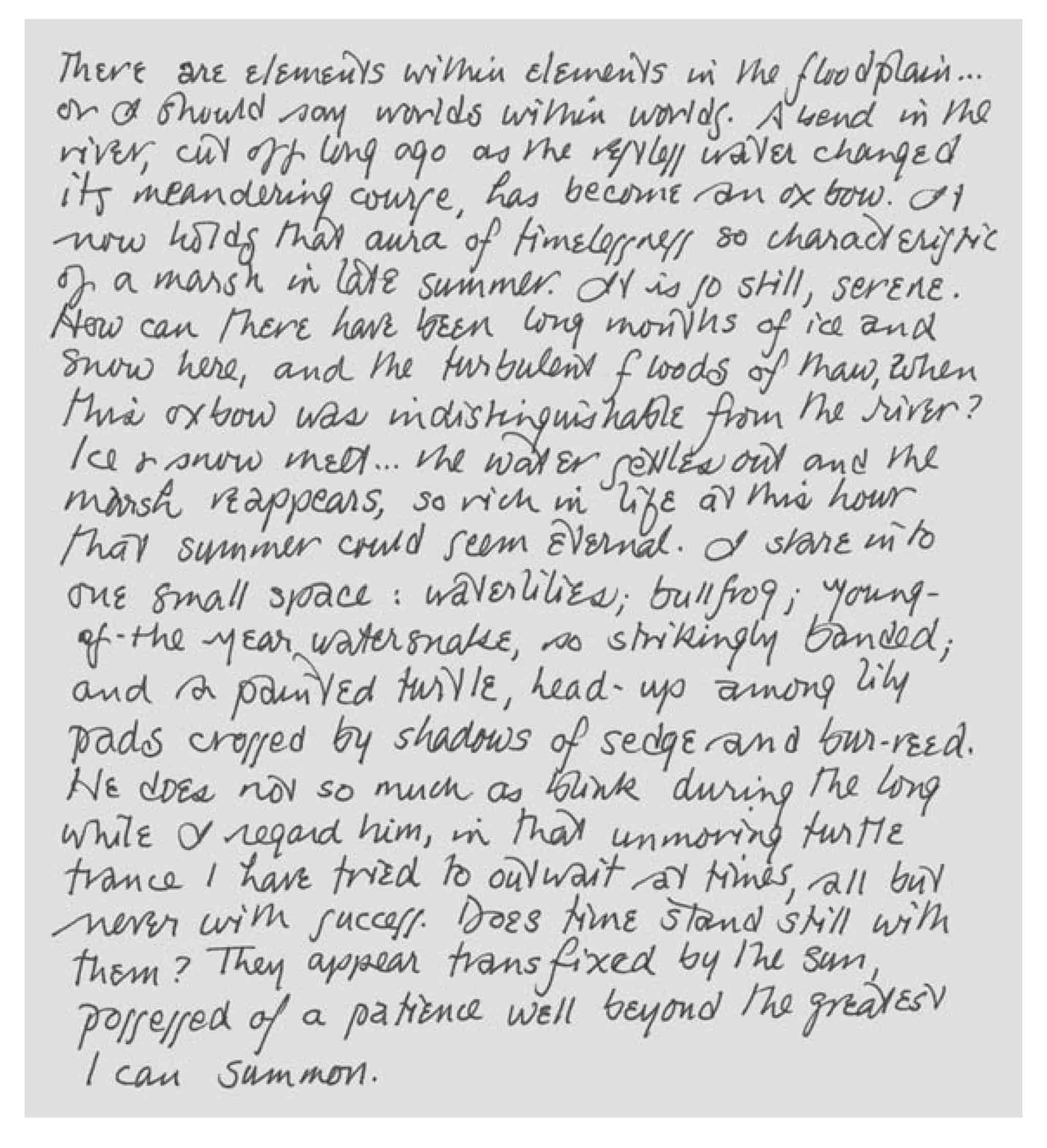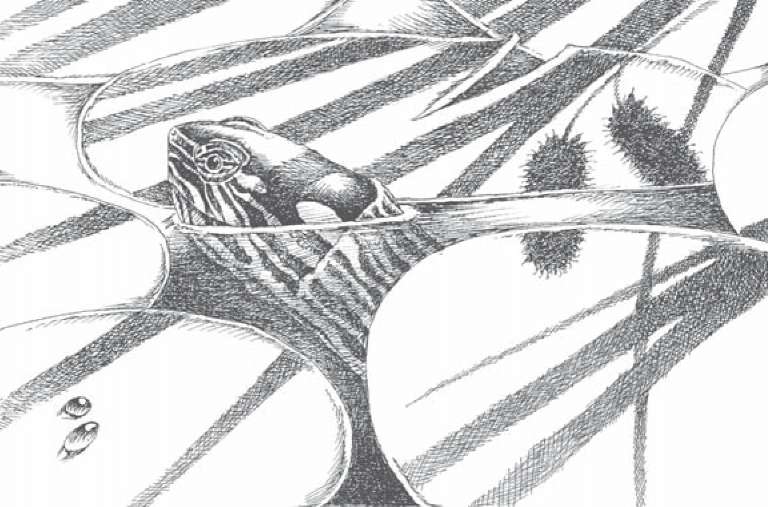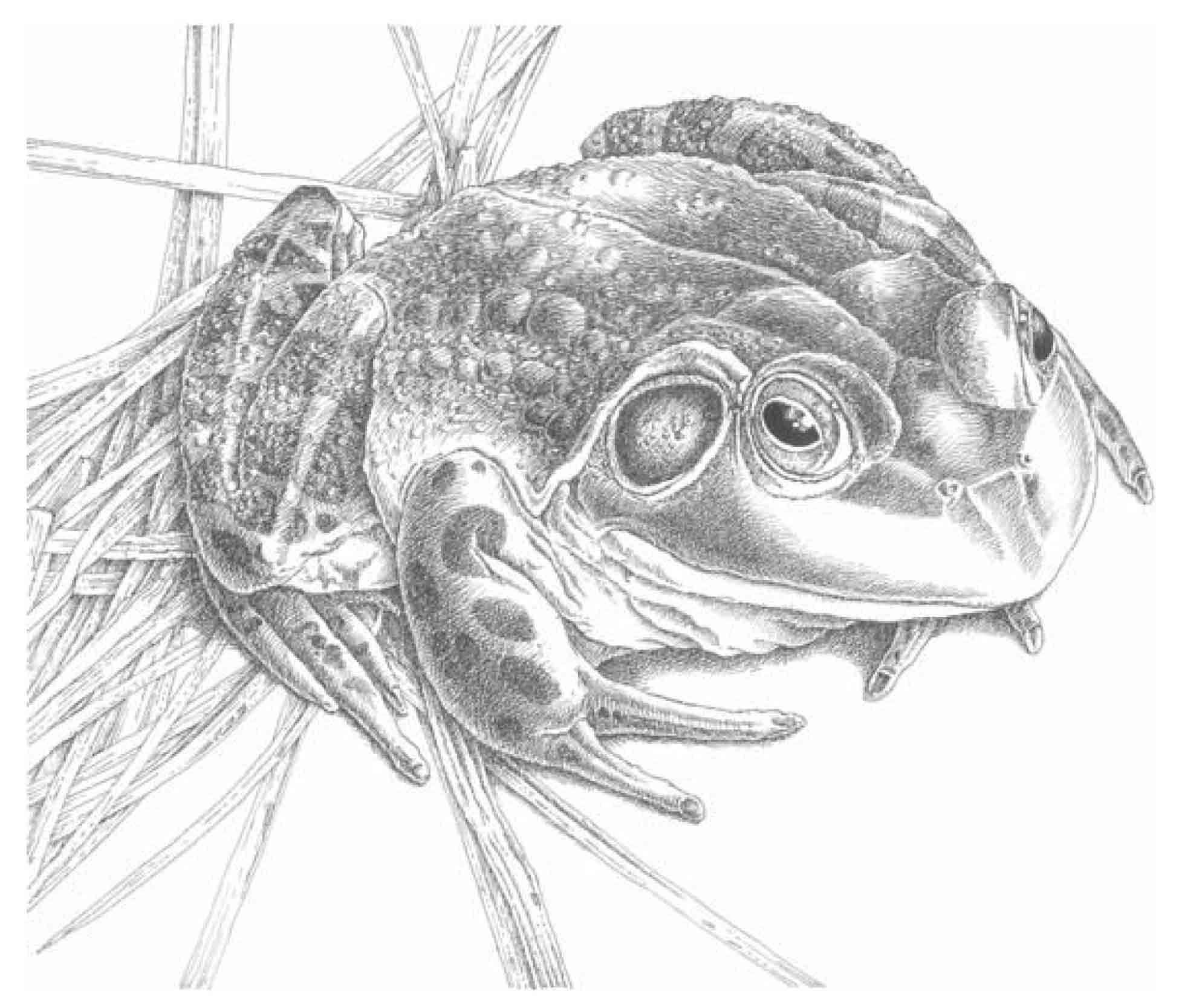Following the Water (13 page)
Read Following the Water Online
Authors: David M. Carroll

Today, as I do every few years, I follow the seasonal stream's bisected cut to the floodplain. By late summer of most years, the brook has gone dry, yet the black silt that lines the level runs along the field is wet, the substrate a never-drying muck. A steep tumble of stones, moist with moss and humidity, drops from the southwest corner of the field's plateau. It is an icy staircase in winter, a rushing waterfall at thaw and after hurricanes or remnants of a tropical storm at summer's end. This silent tracery in the landscape can be brought back to rushing-water life by rainy spells at any season.
I gingerly descend the abrupt, slippery stairway of stones. A third of the way down to the floor of the great hollow into which it drops, I step onto a level rim about three feet wide that encircles the hollow. The steep berm of the state road cuts through the outlet end of this great bowl, which was shaped in the earth by ice and running water. The rim is evidence of the workings of the glacier, the original land
scape designer and engineer of the topography through which I pass.
The contours of the hollow suggest how it came to be. At the breakup of the last ice sheet, during the era that configured the landscape of the glaciated Northeastâa landscape richly laced with waterwaysâa huge block of ice lodged here, one of the chunks left behind by the eroding glacier. For a time the torrents of meltwater that cut the stream channels here divided around the persistent ice, depositing deep alluvial sand and forming the rampart on which I stand. Over greater time the ice block itself was scoured away and disintegrated entirely, leaving this hollow in the earth, the negative space of its former self.
Today, in this silent space left so long ago, I can envision that block of ice with water racing around it, the erosion and deposition that created the hollow and its broader surroundings. Perhaps the ice let go all at once, crushing and shifting stones, or perhaps gradual melting and insistent erosion over time created the ravine that descends to the floodplain, itself shaped by the dynamics of the river's flood pulse. There is a reckoning of time on which a millennium is a minute. Ten thousand years ago can seem like yesterday in a place like thisâa place of earth and water, time and the seasons.
The layers of white pine needles lining the descent are even slipperier than the wet stones. With the assistance of
handholds on smaller trees, I make my way down the wall left by the ice block. I come to the floor of the depression, where over more recent time mucky organic sediments, the stuff of swamps, have been building up. If I were to block the entrance to the culvert and use the berm as a dam, I could turn the hollow into an impoundment almost twenty feet deep and fifty yards in diameter. Because of the workings of water over the year, trees cannot grow here. It is a realm of moss and fern and, in central spaces more open to the sky, marsh marigolds and marsh blue violets, which bloom before the leafing out of the deciduous trees that line the slope. This is another of those places, or spaces, in which I like to stand and be still for a time. It is no great precipice I have come down, but I am not fond of, nor well suited to, the ascents and descents required to get here. And then there is the roadway. But the world goes by up there ... goes on by. It does not stop to look in, much less enter. Even the noise of the world passes overhead, or at least enough of it that in this hidden hollow on the edge of everything I try to avoid I can yet find the stillness and silence in a remnant of the natural landscape I am constantly searching for. This place is emblematic of what the black bear and moose, even the turtles and frogs, have been left with. But it is the human erosion of the landscape, a far different work from that of the glaciers, that drives all of them, great and small, into narrower and narrower corners of the world.
I think of how often I am in an arena of life, for every place in nature is a theater. What dramas have played out upon this little stage, what scenes of long duration or fleeting moments? Time is ever passing by, yet here it seems also to stay. Minutes, hours, can hold their breath in this stillness. Seasons hold in place even as they move through the year. How much water in how many forms has rushed or slowly drifted through here, lingered here? And the living tide as well, of plants and animals, all the kingdoms of life.
Water routes, from oceans to slips of seasonal water like this, have served over deep time as life's migration corridors. Despite the highways, even the largest animals of the dayâbear, moose, white-tailed deer, coyoteâcontinue to move along this cut. Their seasonal movements are not optional; they have no choice but to run every gauntlet, from backyard to superhighway, that unceasing human engineering and manipulation of the planet put in their paths. I know the larger mammals almost entirely by their footprints, for they maintain their ancient secrecy, hiding from man even in the unconscionably marginalized contemporary landscape. Night, even though illuminated by artificial light that can be seen from outer space, continues to be an ally in the clandestine shiftings of these animals. The same function is served by floodplains, other wetlands, and wilder streamsides, where any remaining cover tends to be the thickest.
I find evidence of the animals' passing through. One morning, in a small plot I had turned over in my back-field garden the previous evening, I found a record of those I rarely see, the tracks of a bear, moose, deer, and coyote. I doubt that they had formed a parade, traveling almost in each other's footsteps, but between dark and dawn all had walked over the same small space along their common way. Their tracks were all but superimposed upon each other; I could frame them in a single photograph. Smaller animals following the travel corridor of the ravine are killed on the state road, and they and the largest, bear and moose, are sometimes found as roadkill on the highway.
I climb up the virtually perpendicular wall of the berm, cross the first road, and go down into the steep, rocky ravine that will lead me (with a cautious crossing of the interstate) to the floodplain. As I pick my way among the stones, I see a fan of broad, blue-gray feathers. Startling pieces of a scattered puzzle quickly come together as I make out the remains of a freshly killed great blue heron. The remnants are almost indistinguishable among the muted tones of leaves fallen long ago and the blues and grays of shadow and stone: a shoulder and part of a wing here, a spray of wing feathers there, a leg, the long, curving neck, dismembered parts lying within a few feet of one another. I cannot imagine how this great-winged bird of the open sky, long-legged wader of broad expanses of open-ceilinged wetlands, came
to a violent end in a dry streambed beneath a dense canopy of trees. There are no fish or frogs to hunt here; this is no place for a four-foot-tall heron to land. Or was he struck in high flight and brought to earth here? It is as though a piece of the sky has fallen. I can't think of any habitat suited to a heron in this vicinity ... or was he heading for the river? It is strange how seldom one finds the larger animals dead, save for the endless carnage of road-kill. They are secret even in meeting death. From what I make of the remains, this was a heron in his prime. I often wonder how a heron, or a deer or bear, having survived the vulnerable first or second year, does come to an end. Unable to solve the puzzle I am looking atâfeathers, bits of bone, dried bloodâI regard it as a graphic testament to the great blue heron's final flight.
I find his head and bill. The skull, which is slightly chewed, more likely the work of a scavenger than of what brought him down, is little more than a knob at the base of a long blade, an ornament serving as the handle of a sword. The bill itself has a narrow split in the middle that runs its full length. A narrow line of brilliant yellow borders this crack, which suggests the force of whatever bite or strike brought this bird to ruinâor was it caused by a fall from the sky? Except for the skull of a large snapping turtle (it looks much like the head of a sea turtle), I am not a collector of skulls. But I pick up this once-living sword to give to a friend who studies and photographs birds, and walk on.

Young-of-the-year water snake.
As I enter the floodplain, I follow deer trails through shoulder-high sensitive fern that seems, like so much that grows in such habitats, out of scale. Or I should say that the vegetation dwarfs me; I am the one out of scale here. I come upon several broad, mattedâcrushed, evenâopen areas around some of the towering, many-trunked stands of silver maple. These trampled clearings look far too large
to
be places where deer, or even moose, have bedded down. They seem unquiet in the great green silence here. Are they arenas in which some vital contest took place? At this season it would probably have been the contest of predator and prey rather than a jousting for mates; but there are no bits of fur or bone, no traces of blood. And yet the tale of some great struggle appears to have been written in the monumental space and silence of this floodplain. For me it would take some effort and a club, at least, to make such an impression in the junglelike vegetation here, even though none of it is woody, except for the silver maples.


Painted turtle among lily pads.
I stand so often where much has taken place and will yet take place, events I have little knowledge of. And what is going on even at the moment I stand here, which I have no way of knowing? From the high tree canopy to the dank, alluvial earth, the growth is rank and interwoven; all plants become one plant in the high-summer floodplain. There is space at the edge of the river. I look up at blue vervain, with its cobalt spires set against the milky blue of the August sky. A ruby-throated hummingbird alternately darts and holds
still in the humid air, piercing the crimson throats of the cardinal flowers, vibrantly red against the endless green.

Bullfrog.
The river cuts deeply, darkly, around a right-angle turn here. Submersed plants I cannot identify undulate slowly, rhythmically, in great masses of long strands draped in algae. There are small fish here, dark shapes for a moment, then no more than tails disappearing, forms dissolving in greater darkness. The shallow water of summer (it is almost impossible to remember the spring floods), so slow moving as to be virtually still along this amber-gold, nearly level
lowland reach, becomes restless at the deep-bend meander. Quickened by gravity and the extreme turn of its bed, much of the river's current swirls out of sight beneath an undercut bank. It seems to hold secrets here, some private work it is up to, this river that knows so much of the workings of earth and water, life and seasons, over deep time.
